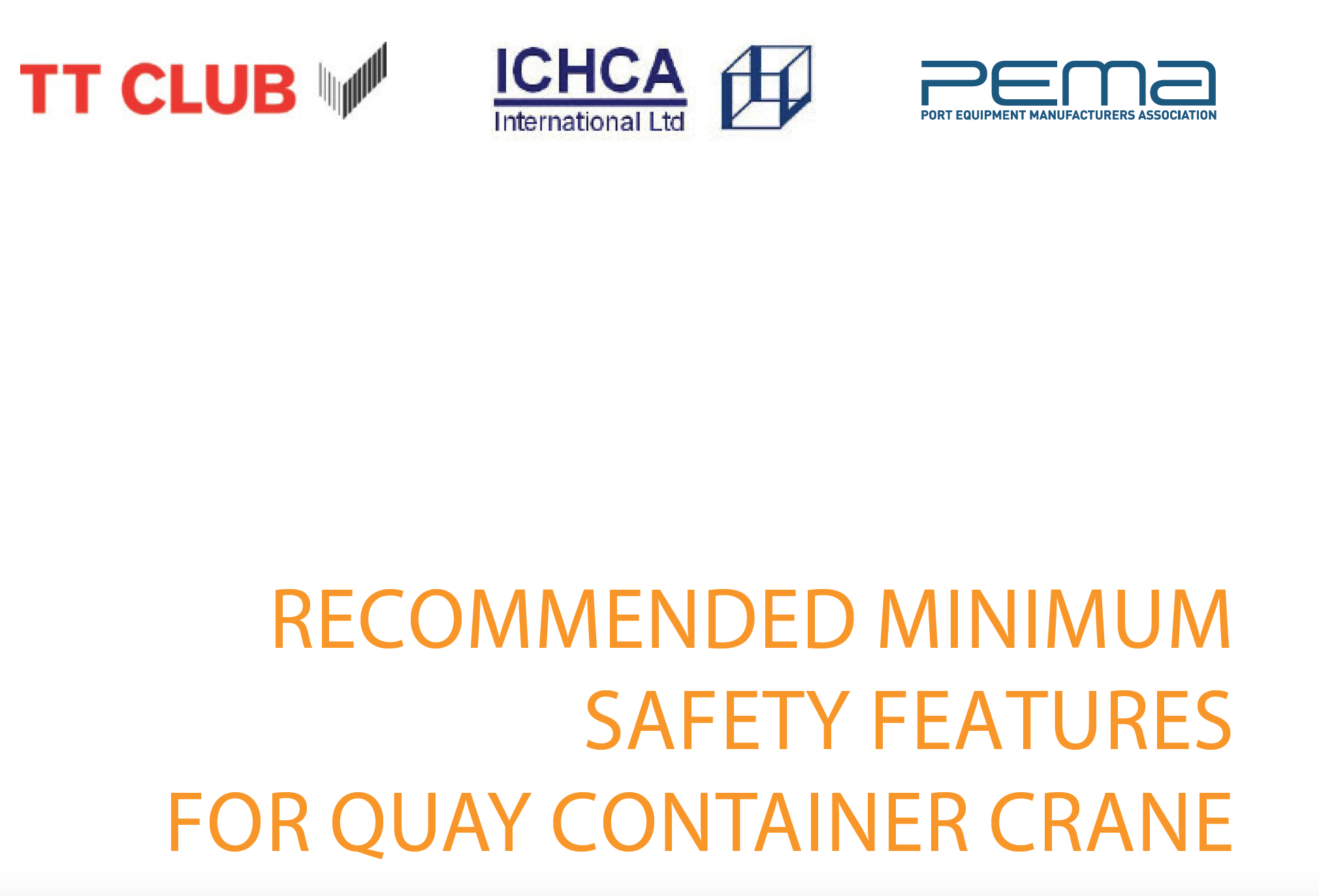
Quay Cranes Minimum Safety Features Updated
Three industry bodies have produced Revision 1 of their Recommended Minimum Safety Features for Quay Container Cranes. Experts from international freight transport insurers, TT Club, together with cargo handling industry experts ICHCA and PEMA recommend minimum standard safety features to promote safety.
London 20 November 2019
The ‘Recommended Minimum Safety Features for Quay Container Cranes’ document has been updated and Revision 1 now available. Published jointly by property, equipment and liability insurance provider TT Club, the Port Equipment Manufacturers Association (PEMA) and ICHCA International, the recommendations update the original document published in 2011. Born out of TT Club’s claims experience, the research has drawn together a formidable group of operational and engineering experience from around the globe to recommend solutions to common safety issues.
The publication calls for a new approach to the crane procurement process in order to recognise safety as an integral part of operational decisions that will minimise exposure to injury, damage and disruption costs over the life cycle of the equipment.
The recommended minimum safety features directly address the causes of accidents and failures identified by TT Club from its claims records. Some of these include:
- Damage caused by high winds
TT Club’s publication ‘WindStorm II – Practical risk management guidance for marine & inland terminals’, emphasises that design features play an important part in minimising exposure. Non-technical people would be surprised at the ‘sail effect’ inherent in the ‘Meccano-like’ structures. There are innumerable instances of cranes being blown along the rails, colliding with neighbouring cranes, or being dislodged from the rails, often leading to structural collapse. While extreme conditions cannot be entirely avoided, the recommended baseline requirements include details for driven braking system and anemometer design and operational controls with an appropriate shutdown function. Further losses can be prevented through the installation of storm pins on both waterside and landside, as well as crane tie-downs on each corner of the crane – with appropriately positioned and engineered anchor points in the terminal apron.
- Damage caused by collision
Accident statistics clearly demonstrate that collisions are a surprisingly recurrent problem. Most commonly, it is the boom of the crane that impacts a ship’s superstructure, resulting in substantial repair costs and consequent downtime. TT Club has for a number of years recommended the installation of radar or laser electronic sensors. This proven technology, integrated appropriately into the operational systems, allows the crane to come to a ‘normal’ stop prior to impact. - Risk of fire
The incidence of fires in quay gantry cranes is low, certainly compared with mobile terminal equipment. However, the position of control machinery high up on the crane structure presents a considerable challenge to most port fire response services. Thus, it is important to install temperature and smoke detection systems and provide alarms for all relevant operational staff. Fully automatic fire suppression is also recommended.
The intention of the ‘Recommendations’ is to urge suppliers to include as standard, not optional, the baseline safety features on this list in all their quotations for container quay cranes. Terminals and buyers are also recommended to incorporate such requirements in their tender specifications. In many instances the safety features identified can be retrofitted to existing equipment. This publication aims to contribute to protecting the substantial asset investment and minimising costs and injuries associated with any type of accident.
The ‘Recommended Minimum Safety Features for Quay Container Cranes’ document Revision 1 now available free from the websites of TT Club, PEMA and ICHCA.
ABOUT TT CLUB
TT Club is the international transport and logistics industry’s leading provider of insurance and related risk management services. Established in 1968, the Club’s membership comprises vessel operators, ports and terminals, road, rail and airfreight operators, logistics companies and container lessors.
As a mutual insurer, the Club exists to provide its policyholders with benefits, which include specialist underwriting expertise, a worldwide office network providing claims management services, and first class risk management and loss prevention advice.
ABOUT PEMA
The Port Equipment Manufacturers Association (PEMA) was established in 2004 to provide a forum and public voice for the global port equipment and technology sectors, reflecting their critical role in enabling safe, secure, sustainable and productive ports, and thereby supporting world maritime trade.
Chief among the aims of the Association is to foster good relations within the world port equipment and technology community, by providing a forum for the exchange of views on trends in design, manufacture and operation of port equipment and technology.
PEMA also promotes and supports the global role of port equipment and technology by raising awareness with customers, the media and other stakeholders; forging relations with other port industry associations and bodies; and contributing to best practice initiatives and information.
PEMA’s growing membership represents a cross-section of port equipment OEMs, suppliers of components including brakes, cable reels, controls, drive systems, tyres and more, providers of software, systems and other advanced technologies, and expert consultants in the field of port equipment and technology.
ABOUT ICHCA INTERNATIONAL
ICHCA International is the only global association dedicated to the promotion of safety and efficiency in the handling and movement of goods by all modes and throughout the supply chain.
Originally established in 1952 and incorporated in 2002, the Association operates through a series of Local, National and Regional Chapters, Panels, Working Groups and Correspondence Groups and represents the cargo handling world at various international organizations, including the International Maritime Organization (IMO), United Nations Conference on Trade and Development (UNCTAD), International Labour Organization (ILO) and the International Organization for Standardization (ISO).
ICHCA International members include ports, terminals, transport companies and other groups associated with cargo handling and coordination. Members of its Panels represent a substantial cross-section of senior experts and professionals from all sectors of the cargo transport industry globally.
Members benefit from consulting services and informative publications dealing with technical matters, best practice advice and cargo handling news.
